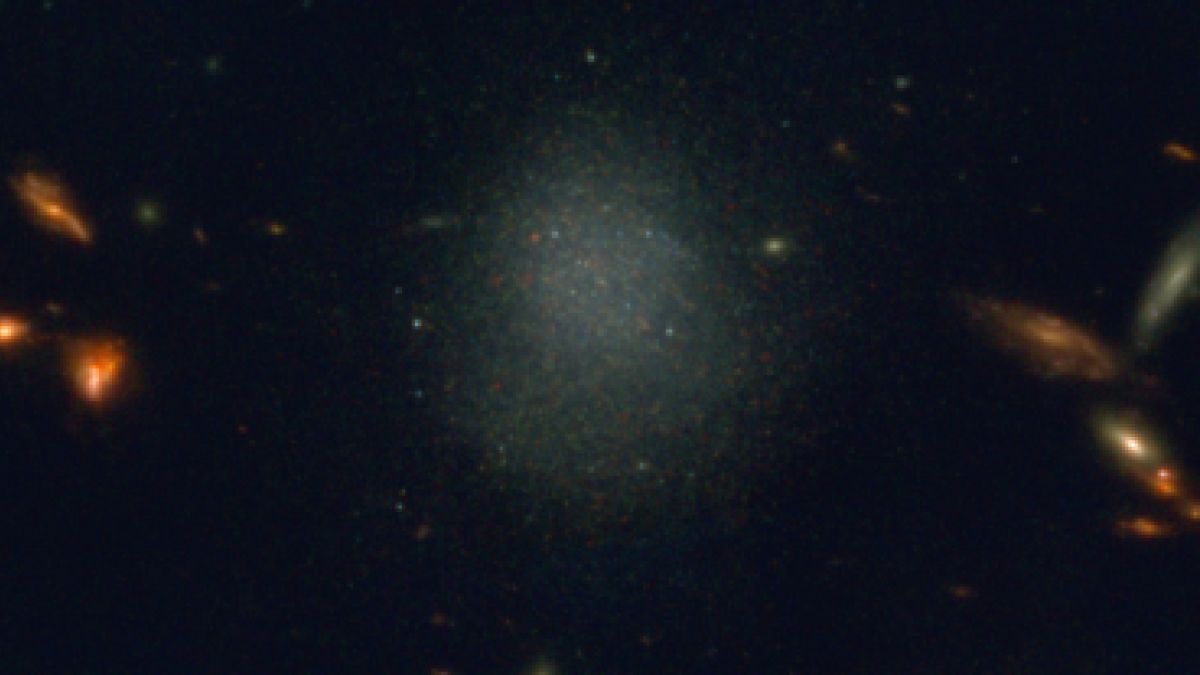Team of astronomers led by ASU scientist discovers galaxy that shouldn’t exist

A color-composite image of PEARLSDG made with JWST NIRCAM data. Individual stars are visible as small points of light in the image. Its somewhat dull color and lack of many bright stars is consistent with its old age and lack of ongoing star formation. Image Credit: NASA, ESA, CSA, Jake Summers (ASU), Jordan C. J. D'Silva (UWA), Anton M. Koekemoer (STScI), Aaron Robotham (UWA) and Rogier Windhorst (ASU)
A team of astronomers, led by Arizona State University Assistant Research Scientist Tim Carleton, has discovered a dwarf galaxy that appeared in James Webb Space Telescope imaging that wasn’t the primary observation target.
Galaxies are bound together by gravity and made up of stars and planets, with vast clouds of dust and gas as well as dark matter. Dwarf galaxies are the most abundant galaxies in the universe, and are by definition small with low luminosity. They have fewer than 100 million stars, while the Milky Way, for example, has nearly 200 billion stars.
Recent dwarf galaxy observations of the abundance of “ultra-diffuse galaxies” beyond the reach of previous large spectroscopic surveys suggest that our understanding of the dwarf galaxy population may be incomplete.
In a newly published study, Carleton and the team were initially looking at a cluster of galaxies as part of the JWST Prime Extragalactic Areas for Reionization and Lensing Science (PEARLS) project.
The dwarf galaxy, PEARLSDG, happened to appear in some of the team’s JWST imaging. It wasn’t the target at all — just a bit off from the main observation field, in the area of space where they weren't expecting to see anything.
Their results have been published in the Astrophysical Journal Letters.
PEARLSDG did not have the usual characteristics of a dwarf galaxy one would expect to see. It isn't interacting with a nearby galaxy, but it also isn't forming new stars. As it turns out, it is an interesting case of an isolated quiescent galaxy.
“These types of isolated quiescent dwarf galaxies haven't really been seen before except for relatively few cases. They are not really expected to exist given our current understanding of galaxy evolution, so the fact that we see this object helps us improve our theories for galaxy formation,” said Carleton. “Generally, dwarf galaxies that are out there by themselves are continuing to form new stars.”
Until now, astronomers' understanding of galaxy evolution showed an isolated galaxy that continued to form young stars or it would interact with a more massive companion galaxy. This theory didn’t apply to PEARLSDG, which presents as an old stellar population, not forming new stars as well as keeping to itself.
In a further surprise, individual stars can be observed in the team’s JWST images. These stars are brighter in JWST wavelengths; it is one of the farthest galaxies that we can see these stars with this level of detail. The brightness of these stars allows astronomers to be able to measure its distance — 98 million light-years.
For this study, Carleton, who is an assistant research scientist at the Beus Center for Cosmic Foundations in the School of Earth and Space Exploration at ASU, and the team used a wide range of data.
This includes imaging data from JWST’s Near-InfraRed Camera (NIRCam); spectroscopic data from the DeVeny Optical Spectrograph on the Lowell Discovery Telescope in Flagstaff, Arizona; archival imaging from NASA’s Galex and Spitzer space telescopes; and ground-based imaging from the Sloan Digital Sky Survey and the Dark Energy Camera Legacy Survey.
JWST’s NIRCam has very high angular resolution and sensitivity, allowing the team to identify individual stars in this distant galaxy. Just like individual cells coming into focus under a microscope, these observations brought the components of PEARLSDG into sharp focus.
Importantly, identifying specific stars in the imaging provided a key clue to its distance — these stars have a specific intrinsic brightness, so by measuring their apparent brightness with JWST, the team was able to determine how far away they are. It turns out that these stars were some of the most distant stars of their type to be observed.
All of the archival imaging data, observed at ultraviolet, optical and infrared wavelengths, was pulled together to study the color of PEARLSDG. Newly formed stars have a specific color signature, so the absence of such a signature was used to show that PEARLSDG was not forming new stars.
The DeVeney Spectrograph at the Lowell Discovery Telescope spreads the light astronomical objects into its distinct components, allowing astronomers to study its properties in detail. For example, the specific wavelength shift observed in features in the spectroscopic data encodes information about the motion of PEARLSDG, using the same “doppler effect” that radar guns use to measure the speed of drivers on Arizona roads.
This was key to show that PEARLSDG is not associated with any other galaxy and is truly isolated.
Additionally, particular features in the spectrum are sensitive to the presence of young stars, so the absence of those features further corroborated the measurements of the absence of young stars from the imaging data.
“This was absolutely against people's expectations for a dwarf galaxy like this," Carleton said.
This discovery changes astronomers' understanding of how galaxies form and evolve. It suggests the possibility that many isolated quiescent galaxies are waiting to be identified and that JWST has the tools to do so.
This research was presented at January’s 243 AAS press conference: Oddities in the Sky, and can be viewed here.
More Science and technology

ASU professor wins NIH Director’s New Innovator Award for research linking gene function to brain structure
Life experiences alter us in many ways, including how we act and our mental and physical health. What we go through can even change how our genes work, how the instructions coded into our DNA are…

ASU postdoctoral researcher leads initiative to support graduate student mental health
Olivia Davis had firsthand experience with anxiety and OCD before she entered grad school. Then, during the pandemic and as a result of the growing pressures of the graduate school environment, she…

ASU graduate student researching interplay between family dynamics, ADHD
The symptoms of attention deficit hyperactivity disorder (ADHD) — which include daydreaming, making careless mistakes or taking risks, having a hard time resisting temptation, difficulty getting…